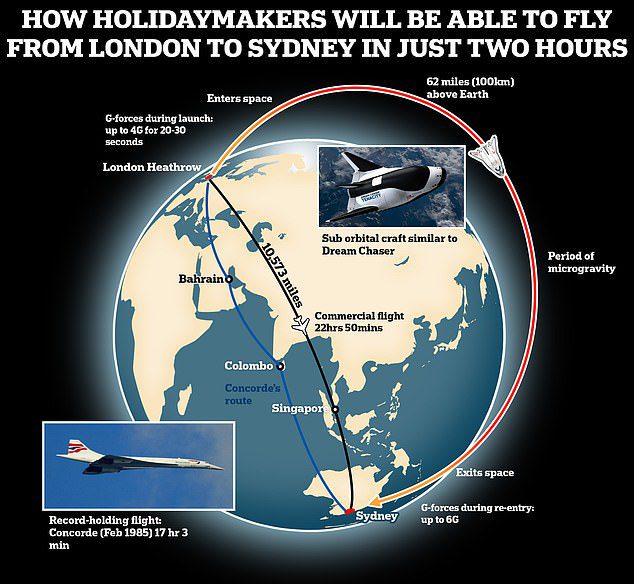Commercial flight times could be reduced by more than 20-fold within a decade, thanks to groundbreaking plans that aim to transport passengers between countries via space.
Aviation experts are actively exploring how ordinary citizens would adapt to short periods of zero gravity during long-haul journeys, such as those between the United Kingdom and Australia.
This article delves into the potential of suborbital flights to drastically shorten travel time, while highlighting the advantages and challenges associated with this futuristic mode of transportation.
Breaking the Boundaries and Embracing Zero Gravity
Typically, a commercial flight from London to Sydney spans over 22 hours. However, suborbital flights hold the promise of completing this journey in a mere two hours, surpassing the record set by Concorde back in 1985. The implications of such a feat are monumental, not only for travellers seeking faster connections but also for the aviation industry as a whole.
However, suborbital flights necessitate grappling with unique challenges. Passengers would experience significant G-forces during take-off and landing, requiring them to remain securely fastened in their seats. Additionally, mid-flight would subject travellers to a state of weightlessness, prompting them to keep their seat belts buckled throughout the journey.
Furthermore, to mitigate discomfort, passengers may be advised to recline their seats during launch and employ certain techniques, such as clenching their buttocks, to help ease the transitions in and out of the Earth’s atmosphere.
Passengers are set to fly from London to Sydney in under two hours via space within the decadehttps://t.co/2drGBET7xY
— LBC (@LBC) May 15, 2023
Research on Human Adaptability
The UK Civil Aviation Authority (CAA) has undertaken a comprehensive study to evaluate the impact of suborbital space flights on the human body. Recently published in the journal Aerospace Medicine and Human Performance, the study indicates that most individuals can cope with the G-forces encountered during suborbital flights.
However, it also highlights potential physiological responses that may require further examination. Though, it is reassuring to know that the findings suggest that with ongoing research and refinement, the challenges associated with space travel can be addressed effectively.
Suborbital vs. Orbital Flights
It is important to differentiate suborbital flights from their orbital counterparts. Suborbital flights reach space but lack the velocity necessary to sustain orbit, necessitating a return to Earth. This differs from orbital flights, which possess greater velocity, enabling them to remain in space and complete multiple orbits around the Earth.
Suborbital flights, exemplified by Richard Branson‘s Virgin Galactic, are currently priced at over £350,000 per seat, but industry experts anticipate a decrease in cost over time, making them a viable option for intercontinental travel accessible to a broader audience.
How will These Flights Work?
The mechanics of a commercial suborbital flight involve a carefully orchestrated sequence of events to ensure the safety and comfort of passengers. Departing from a specially adapted launch site, located either at an existing airport or a more expansive facility conducive to space travel, the suborbital craft is poised for an extraordinary journey.
As the engines ignite, passengers would experience a powerful surge, subjecting them to G-forces four times stronger than Earth’s gravity. This intense period, lasting around 20 to 30 seconds, occurs immediately after blast-off but gradually subsides.
Following the initial burst of acceleration, the suborbital vehicle would enter a phase of microgravity, creating a weightless environment. To prevent travellers from floating freely, they would be securely strapped to their seats, allowing them to enjoy the exhilarating sensation of weightlessness while maintaining a sense of stability.
As the journey nears its destination, another crucial phase begins. During descent, the G-forces experienced by passengers would peak at six times the force of Earth’s gravity for a duration of 10 to 15 seconds. However, this elevation in G-forces carries a potential risk.
When exceeding 5G, individuals, including both pilots and passengers, are susceptible to a phenomenon known as blackout, wherein blood drains from the head due to the intense forces involved. Therefore, careful measures and precautions must be implemented to mitigate this risk and ensure the well-being of everyone on board.

A Glimpse into the Future: The Advantages and Drawbacks of Suborbital Flights
Experts project that commercial suborbital flights between countries could become a reality within the next decade. As research advances and technology evolves, suborbital travel holds tremendous potential to revolutionise the way we explore the world.
Furthermore, shorter travel times would unlock new opportunities for business, tourism, and global connectivity, fostering economic growth and cultural exchange on an unprecedented scale.
However, while the prospects of suborbital travel are exciting, there are significant challenges to overcome. Apart from the physiological adjustments that passengers must make, the exact cost of commercial suborbital flights remains uncertain.
Currently priced at a premium, it is essential to find ways to make this mode of transportation accessible to a wider range of individuals. Additionally, safety considerations and regulatory frameworks must also be rigorously established to ensure the well-being and security of passengers.
Conclusion
With some final thoughts in mind, the concept of travelling from London to Sydney in a mere two hours through suborbital flights represents a thrilling leap forward in aviation technology. By significantly reducing travel times and unlocking new possibilities, this innovative approach could reshape the future of global transportation.
What’s more, while hurdles and challenges persist, ongoing research and development offer hope that suborbital travel will soon become a reality, propelling humanity into an era of unprecedented connectivity and exploration.
Finally, it seems that only time will tell if suborbital flights will be well received or not, but either way, it’s an amazing advancement that at one time or another would have only been a dream, not a reality.









